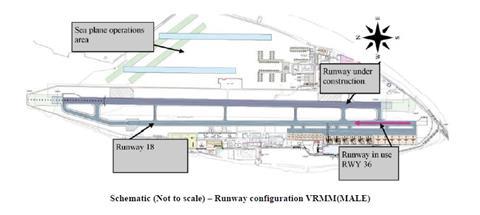A lack of pre-flight planning and runway confusion nearly caused an Airbus A320 operated by Indian low-cost carrier IndiGo to land on an unfinished runway at Male, Maldives.
India’s Director General of Civil Aviation (DGCA) classifies the 3 February 2019 incident as a “marginally avoided” controlled flight into terrain.
At 15:06 local time, after operating a service from Mumbai, the aircraft (VT-INY, MSN3863) came to within 12ft radio height of touching down on the unfinished runway parallel to the assigned runway 36.
“The operating crew was aware of the existence of an under-construction runway parallel to the existing active runway,” states the DGCA report into the incident.
“However, there was confusion regarding the actual runway in use during approach and crew made an approach to the under construction runway. At about 12ft radio height, the pilot in-command (PIC) not being convinced that the runway to which they are approaching is the active runway carried out a missed approach.”
The aircraft subsequently made a go around and landed safely. None of the 100 passengers or six crew was injured.
The DGCA’s investigation revealed that the crew had expected to land on runway 18, and were informed that the unfinished runway was parallel to runway 18 on the left.
Upon reaching the vicinity of Male the crew was informed by air traffic control (ATC) that Runway 36, and not 18, was the operational runway. The crew was also informed that ILS was not functioning, and were advised to make an RNAV approach for Runway 36. Instead, the crew asked for and performed a VOR36 approach.

At 400ft radio altitude the PIC, flying the aircraft, expressed reservations about the runway the aircraft was approaching, noting the large ‘X’ cross marks, but the first officer insisted this was the correct runway.
“The crew also did not sight the precision approach path indicator visual aid during the first approach,” says DGCA. “The aircraft descended to 12ft radio altitude above the runway under-construction, by this time the PIC was still unable to confirm the active runway performed a go-around.”
Subsequently, air traffic control confirmed that they had nearly come down on the wrong runway.
The DGCA noted that neither crew had flown to Male and that planning for the flight was inadequate. Moreover, it believed the PIC showed a lack of assertiveness, and that the flight was dispatched with insufficient information.
In addition to training for the crew involved, the DGCA recommended that IndiGo avoid using relative directions such as left/right, instead replacing them with cardinal directions – north, south, east, and west.
The DGCA notes that the Maldives was asked to aid in the investigation, but did not respond to queries.


























